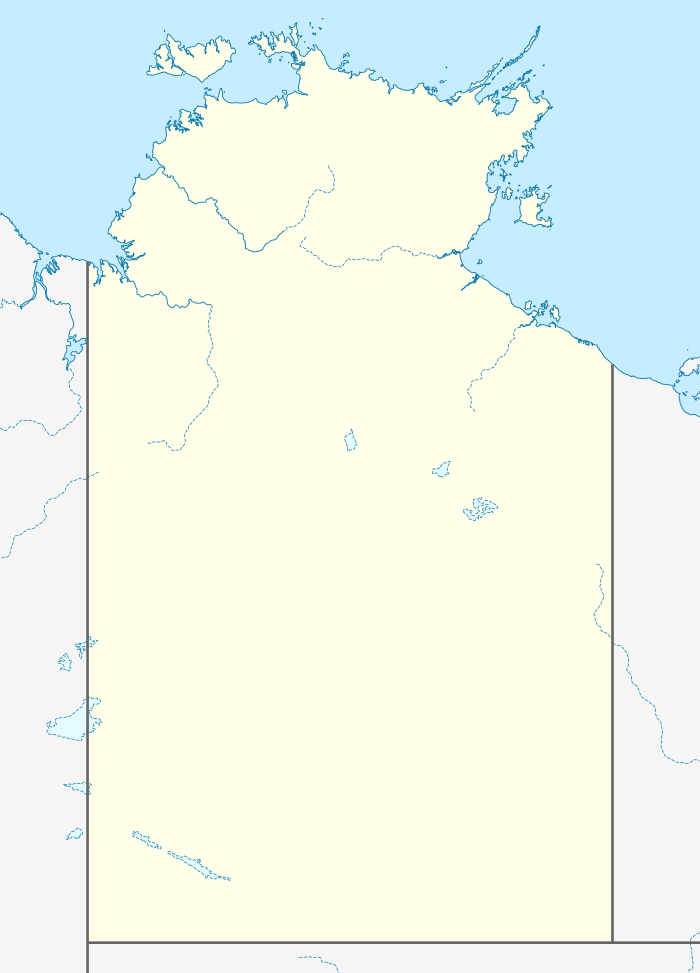Wadeye, Northern Territory
| Wadeye Northern Territory | |||||||
|---|---|---|---|---|---|---|---|
 Wadeye | |||||||
| Coordinates | 14°14′0″S 129°31′0″E / 14.23333°S 129.51667°ECoordinates: 14°14′0″S 129°31′0″E / 14.23333°S 129.51667°E | ||||||
| Population | 1,627 (2006 census)[1] | ||||||
| Postcode(s) | 0822 | ||||||
| Elevation | 11 m (36 ft) | ||||||
| Location | 394 km (245 mi) from Darwin | ||||||
| LGA(s) | Victoria Daly Shire | ||||||
| Territory electorate(s) | Daly | ||||||
| Federal Division(s) | Lingiari | ||||||
| |||||||
Wadeye is a town in Australia's Northern Territory. Pronounced wod-air-yer, it was formerly known (and is still often referred to) as Port Keats. At the 2006 census, Wadeye had a population of 1,627.[1]
Location and access
The town is remote, situated on the western edge of the Daly River Reserve about 230 km by air south-west of Darwin. It lies close to the Hyland Bay and Moyle Floodplain Important Bird Area, identified as such by BirdLife International because of its importance for large numbers of waterbirds.[2] Roads to the community are cut by flooding during the wet season, when access is only possible by light aircraft or coastal barge.
History
A mission station was founded by Roman Catholic Father Richard Docherty in 1935 at Werntek Nganayi (Old Mission), and subsequently moved to a new location with superior water, gardening and building sites and landing place.[3]
Since 2007 violence between the Judas Priest and Evil Warriors gangs has declined.[4]
Description
Wadeye is mainly inhabited by Indigenous Australians. The inhabitants include seven language groups, the main language that is spoken being Murrinhpatha. The indigenous population has five traditional bands or kinship groups of Nangiomeri, Marimanindji, Marithiel, Maringar and Mulluk Mulluk. Port Keats is also the site of a temporary ADF Radar site that is used during exercises conducted in the Top End.
Art and culture
Nym Bundak was the first painter in Wadeye who had international interest. He was asked by Bill Stanner, an anthropologist who had come with Richard Docherty in 1935, to produce pieces explaining traditional law, which he made after he saw a map produced by Stanner. He produced many bark paintings of the dreaming which informed Stanner's research. Today in Wadeye Mark Crocomb follows in the footsteps of Stanner collecting history and languages before they are lost. Following in the tradition of Nym Bundak is Richard 'Skunky' Parmbuk. He is one of many artists filling the space left by Nym in Wadeye.[5][6]
References
- 1 2 Australian Bureau of Statistics (25 October 2007). "Wadeye (Urban Centre/Locality)". 2006 Census QuickStats. Retrieved 11 February 2012.
- ↑ BirdLife International. (2011). Important Bird Areas factsheet: Hyland Bay and Moyle Floodplain. Downloaded from http://www.birdlife.org on 2011-12-23.
- ↑ F.X. Gsell, The Bishop with 150 Wives (Angus and Robertson, Sydney, 1956), pp. 150-2; J. Pye, The Port Keats Story (Kensington, 1973); Port Keats 1935-, German Missionaries in Australia.
- ↑ http://www.abc.net.au/worldtoday/content/2007/s1931074.htm
- ↑ Graeme K Wardand Mark Crocombe (15 November 2011). "Port Keats painting: Revolution and continuity" (PDF). Retrieved 2011-01-13.
- ↑ "Wildlife Enterprise Centre". 15 November 2011. Retrieved 2011-01-13.